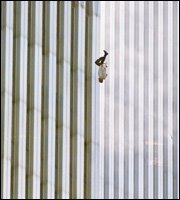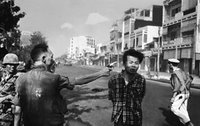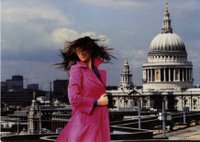
Last night Channel 4 showed a documentary on 9/11 which centred around the images of that horrific autumn day. Specifically the 'Falling Man' (also covered in Esquire above). To me the images of people gathered at the top of the WTC hanging out of one of the worlds tallest buildings trying to breath seemed so surreal yet oddly relatable that they managed to truly capture the total horror of the events that morning. The discrepancies of scale, the sinister gothic buildings, their suits and ties. I never liked the WTC when I had the chance to visit. There were several elevator shafts to take you to the top. The building swayed. I felt unsafe and refused to go up to the glass where, my sister informed me, a helicopter was hovering hundreds of feet BELOW us.
 The Pulitzer prize winning photographer of this 9/11 image is no stranger to history, as the article notes. He was there when Bobby Kennedy was shot. There is something unsettling about a photographer who can shoot a role of film that documents what is essentially a man moments before his death. I cant for example fully comprehend how the photographer of this famine image was able to take his photo and walk away doing nothing to help that child. That’s an impossible reaction and not one I would have had. He later regretted his actions but stated as a reason that the aid agencies had advised the victims were ‘disease ridden’. It became a Pulitzer prize winning image. Is that documenting history, sick voyeurism or a hunt for glory with a veneer of an excuse?
The Pulitzer prize winning photographer of this 9/11 image is no stranger to history, as the article notes. He was there when Bobby Kennedy was shot. There is something unsettling about a photographer who can shoot a role of film that documents what is essentially a man moments before his death. I cant for example fully comprehend how the photographer of this famine image was able to take his photo and walk away doing nothing to help that child. That’s an impossible reaction and not one I would have had. He later regretted his actions but stated as a reason that the aid agencies had advised the victims were ‘disease ridden’. It became a Pulitzer prize winning image. Is that documenting history, sick voyeurism or a hunt for glory with a veneer of an excuse? The Cambodian image is another Pulitzer winner. The image also captures a man nanoseconds before death and freezes it. . His photograph captures history, speaks louder than words. It all feels very uncomfortable.
The Cambodian image is another Pulitzer winner. The image also captures a man nanoseconds before death and freezes it. . His photograph captures history, speaks louder than words. It all feels very uncomfortable. The Channel 4 footage shows people in real time falling to their deaths that day. Other than the humbling interviews with the relatives, it left me feeling angry. Angry with the overriding suggested angle of the programme that America buries what is uncomfortable and unheroic and that this is a ‘failure’. I didn’t feel that was the case. To a degree maybe. But those images are the last seconds in a fight for life. They are simply too raw, too personal to the families involved. What baffled me was the obsession some journalists had with finding out who the falling man was. What purpose does that serve. Im almost relieved that there was no certainty in his identification and that he remains unidentified now.
Its natural that the US wants images of heroic rescuers raising the flag in the ruins to be the world images that circulate in a time of war. Recently I saw a picture of the London Blitz. It showed a dead woman in a suit on the pavement lying in the rubble following a lunchtime bombing raid. Her legs looked awkward, her clothes awry. Her dignity gone. An airraid warden was checking to see if she was alive. She looked so ordinary and relatable. It was so real. Im sure such images were not publicized during the war even though this was unusual, a great city under attack by air raid for the first time in its history, in any history, its civilians being slaughtered. It is certainly not an image I will forget in a hurry (I couldn’t find it on the net) and it is not one I was ever shown at school or college or in museums.
I do really wonder if there isnt a part of the msm that continues to bury its own images not because they are uncomfortable to look at but because you would feel the way you should? After all in this case if it’s a failure story to beat up the Americans, then im sure the world media would readily oblige. Abu Ghraib is a daily front piece. The msm has never recoiled from horror before.
Why the silence? Because you might end up like me last night, in tears, hot with anger and unable to sleep, reminded of my reaction that day. When I walked to work this morning it still hadn’t disappeared, that sick feeling of anger I felt time and again in the 70s, 80s and all at once that September morning. All I kept thinking: ”you unspeakable bastard”
The images cant be swept under the carpet but equally they musnt be abused. They are a breakaway moment in history. The world pre 9/11 and the world after it. Images like these make you understand, react, learn. There is a burden of responsibility in the future to work out how we deal with our own history captured like this, in real time, by photographers and cameramen - and ensure as we grow up with Abu Ghraib we don’t forget the horror that took us there.


8 Comments:
I don't know what to say Alison. The picture of that starving baby is going to haunt me. What a shitty world we live in sometimes.
When confronted with pictures from 9/11 I have the same reaction that you describe. I guess somehow we forget - or somehow put it aside to enable us to continue on with life. The images shouldn't be hidden away ever. Like the images of the Holocaust - we need them to remember.
As for the photographers - dang. I don't know what to say about that. You've left me speechless.
They are an odd bunch its hard to tell whether they are a force for good or bad. I worked in the newspaper industry when i left uni and when Diana died the chief picture editor had the photos taken of her dying inside the car. They were never published but they got taken to the pub and poured over by everyone there to my utter disgust. I refused to look.
You react to the picture of the baby as i did - that becomes acknowledgement, a chance to challenge whats wrong there if need be. The images of 9/11 tell a story and give context but they are hard to look at with suffering families forever reminded so graphically of what happened, it feels disrespectful. How do we deal with all this information rationally, fairly, with balance and in context, as part of our history in the modern era? I really dont know! After all its used to challenge us daily in the msm but is it always balanced? no way!
when i say he had the photos taken i mean in his possession/wired to him (as all the papers did) not that he had asked they be taken, eek, quickly clarify!
Alison, you didn't mention, and I think it's worth mentioning, that the image of that starving child and the knowledge that he could have saved it haunted the photographer so badly that 3 months after winning the Pulitzer Prize for it, he committed suicide.
Was that the reason for his suicide though? I couldnt find any more to be certain. Maybe. In which case yes its worth mentioning.
I wonder how that photographer received the Pulitzer Prize, with a big smile and thanks everybody for voting for me. It is a sick world and that's one of the sickest pictures I have ever seen. Even pictures of the Holocaust don't leave a scar as raw as that. As for the picture of the 'falling man' if that was a picture of your loved one you would want to find and seriously damage the photographer. Sadly though these images are all part of today's world and 'sick' pictures will continue to be taken, we will all sit down with a 'nice cup of tea' to watch the latest in the war episode. There are no answers just the intensity of the msm to continue to sell papers and to watch the right tv chanel. Would it stop if we discontinued to read newspapers or shut off the tv - I don't think so because we can't - we are drawn to look at pictures as hideous as the ones you show, it's all part of human nature.
I agree with you anonymous, i find it hard to work out how to look at the images. Sometimes these images do propel us to action but should we glorify them, are they prize worthy? its all about how we handle this new way of documenting life, our history, the world we live in in view of the msm strangle hold. Whats also sick is what transpired that day in september, the corruption that allows that child to die that way. I understand the photographer killed himself but i dont know for sure it was down to guilt. And if it was then its worth bearing that in mind.
As for papers/media - you are 100% right. I was angry about the 9/11 programme on thursday and this is me trying to work it all out.
We taped this show to perhaps watch later. I doubt we will. I knew that it would be depressing when we decided to not watch it. Maybe one day. As for the dying child's photo; I hope that I would have the strength to say "screw it" and picked up and have taken that poor babe to safety. Damn.
Post a Comment
<< Home